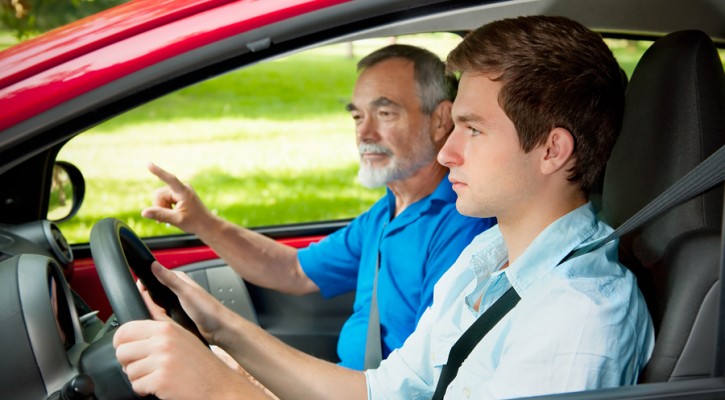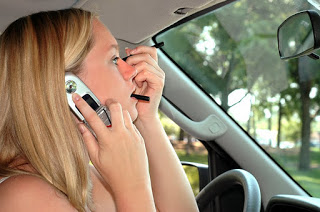Monthly Archives: May 2009

Driver Training: Teens and Seat Belt Use
May 28, 2009
As many drivers know, teens have a higher fatality rate in motor vehicle crashes than any other age group. One reason for this is that teens have lower seat belt use rates than adults. In 2006, the National Highway Traffic Safety Administration (NHTSA) reported that 76% of drivers aged 16 to 24 used their safety belts; this figure was lower than for any other age group. Perhaps more telling, in 2006 the NHTSA also reported that 58% of 16- to 20-year olds who were involved in fatal motor vehicle collisions were not wearing seat belts.
In some states, the numbers are even worse: An observational study by the Utah Department of Health found that the teen seat belt use rate was only 67% compared to a state safety belt use rate of 88.6%. The University of Missouri reports that between 1995 and 2000, only 24% of fatally injured teen drivers were buckled up, compared to the national average of 36% for teen drivers who died in motor vehicle crashes during this time.
Why don’t teens wear safety belts? The Utah Department of Health study reported that teens offer the following reasons:
- Forgetting to buckle up
- Wanting to be cool
- Peer pressure
- Seat belts are uncomfortable
- Traveling only a short distance
- A feeling of invincibility
The same study also found that the teen seat belt use rate falls when other high-risk factors are present, such as when teens:
- Drive under the influence of alcohol
- Drive at night
- Have multiple teen passengers
- Are driving without a driver’s license
What can we do to increase the seat belt use rate among teenagers? Initiatives include:
- The University of Missouri study found that whether or not teens will use safety belts is established well before the teens begin driving. Parents who want their teens to buckle up must wear their own safety belts and use child restraints and seat belts on their children from birth. The University of Missouri study found that teens were heavily influenced by a lack of seat belt use by the adults in their lives, and the Insurance Institute for Highway Safety reports that teen seat belt use increases over time when strict parental limits are set. In an NHTSA study, about half of the unbelted students observed at 12 high schools were riding with adults who were wearing seat belts.
- Education and outreach are important methods of encouraging safety belt use. Many teens do not understand the physics of a car crash. The University of Missouri study found that teens are not well-informed about the consequences of crashes where occupants are unbelted. Teens also tend to extrapolate urban legends to a statistical majority, so they need to learn how to apply critical thinking skills to traffic safety concepts.
- Graduated Driver Licensing programs in many states have seat belt use requirements. For example, in North Carolina, graduated licensing law includes provisions for fines for up to $100 for safety belt violations by new drivers. Teens need to be educated on their state requirements and the penalties for violating them; parents need to enforce GDL laws as part of their house rules.
- Parents who are purchasing a vehicle for their teens should consider models with safety belt reminder systems.
- Schools have the opportunity to increase seat belt use by requiring student drivers and passengers to be buckled up when entering and leaving campus. Enforcement can be tied to vehicles with parking decals; penalties can be tied to restriction of and eventual loss of parking privileges.
- A primary enforcement safety belt law is effective in increasing safety belt use among teens, particularly among those who absolutely refuse to wear them otherwise. The NHTSA reports that teens are more likely to wear seat belts in states with primary enforcement laws versus in states with secondary laws. Teens often perceive indifference to safety belt use on the part of law enforcement in secondary enforcement states, because they don’t understand that enforcement is restricted by the law.
“Click It or Ticket” campaigns are also successful in increasing overall seat belt use rates.

Driver Education: Why New Drivers Should Take a Defensive Driving Class
May 27, 2009
Though teens receive driver training prior to being licensed and are subject to Graduated Driver Licensing laws to protect them from statistically high-risk driving situations, training shouldn’t end when teens get their licenses. Reasons for this include:
1. Newly licensed teenage drivers are often giddy with newly acquired freedom. They will assimilate more information once they have become accustomed to the increased level of independence they’ve earned.
2. Teens may pick up bad driving habits, such as carelessness and recklessness, from riding with other teens.
3. Teens who received defensive driving lessons prior to gaining driving experience often have difficulty applying those lessons until they are licensed.
4. New drivers often suffer from information overload; spreading driver training lessons out over time means they will retain more in the long run.
5. Though drivers are statistically less likely to be injured or killed in motor vehicle crashes as they leave their teens, the overall risk remains high throughout the teenage years when compared to other age groups.
Taking a defensive driving course six to twelve months after licensure is very helpful for new drivers. Teens can take the course online or in a classroom. Typical topics include:
- Crash statistics and the physics of vehicle crashes
- Crash prevention techniques
- Occupant protection devices (such as seat belts and airbags)
- Driving under the influence of alcohol
- How to share the road with large trucks, motorcyclists, and pedestrians
- Dealing with stress and drowsiness while driving
- The hazards of speeding
- An overview of traffic laws in your state
When teens take a defensive driving class, they have the opportunity to apply concepts that may have seemed abstract prior to licensure. For example, crash prevention techniques are easier to appreciate once the driver has experience in maneuvering a vehicle; unlicensed teens are unlikely to understand how much stress and sleepiness negatively impact their driving abilities. However, as newly licensed drivers, teens haven’t been driving long enough to have ingrained driving habits, so they still have an opportunity to eliminate unsafe practices and become safe drivers.

Driver Education: Teens and Defensive Driving
May 20, 2009
Teens are often urged to “drive defensively.” This is an excellent suggestion for any driver and is of particular importance to new drivers, who have limited experience in dealing with emergency situations and who are developing driving habits they may have for the rest of their lives. But what is defensive driving, exactly?
Driving defensively means driving in such a way that you reduce the risk of a crash, which will in turn prevent injury to yourself and others. It means going beyond following the rules of the road to put safety first. For example, if another driver is supposed to yield the right-of-way to you but fails to do so, as a defensive driver you will yield the right-of-way to that driver to avoid a collision.
Defensive driving isn’t just important in emergency situations, however. Using defensive driving techniques will help you:
- manage stressful driving conditions
- avoid traffic tickets
- keep your vehicle in good mechanical condition
- keep your driver’s license
There is no doubt that driving can be stressful, especially when traffic is heavy. One element of defensive driving is to maintain an adequate following distance from the vehicle in front of you. This decreases the risk of a rear-end collision if the vehicle ahead stops suddenly. Other ways to manage stress by driving defensively include:
- driving at a speed that is appropriate for conditions (which may be lower than, but is never higher than, the posted speed limit)
- checking intersections for cross traffic when you have a green traffic light (in case another driver runs the red light or a pedestrian is in the crosswalk)
- keeping a space cushion on all sides of your vehicle so you have room to maneuver if necessary
- watching the road ahead of your vehicle and checking your mirrors every three to five seconds so you notice hazards before they become a problem
Avoiding traffic tickets is especially important to drivers who are subject to a Graduated Driver’s Licensing program; these programs often restrict advancement to the next stage of licensure unless very few or no points accrue on the teen’s license. Traffic violations also mean hefty insurance increases for young drivers, who are already paying high rates because they are in a high-risk category. But following the rules of the road only when you’re worried about getting a ticket is not sufficient; if you’re not concentrating on driving defensively, you’re likely to make mistakes due to your reduced level of alertness. These mistakes could result in a ticket or even a crash, and even a minor fender-bender can result in points on your driving record.
Part of defensive driving is making sure that your vehicle is in good mechanical condition. Don’t wait for a breakdown to get your vehicle checked out; your owner’s manual offers a schedule of suggested maintenance tasks. Tires with low air or worn tread reduce your traction and make skids more likely. Your brakes need to be in top condition at all times. Even something as simple as not having windshield wiper fluid in the reservoir can impair your visibility and increase your chances of a crash. Don’t just put gas in the car and drive; take responsibility for ensuring that your vehicle is ready for the road.
As you’ve probably learned from your driver handbook, having a driver’s license is a privilege, not a right. This means that your driver’s license can be taken away, including for some non-driving offenses.
Driving defensively is part of an overall pattern of responsible behavior that will help you keep your license and the increased level of independence that comes with it.

The Importance of a Safe Driving Attitude
May 15, 2009
One important aspect of driver training is the development of a safe driving attitude. The reason a safe driving attitude is so important is because you will make many choices as you drive, and your driving choices have consequences. There are many benefits to a safe driving attitude, including:
- limiting stress while on the road
- saving you money on tickets and increased insurance costs
- helping you keep your driver license
- reducing your chances of being in a crash
To have a safe driving attitude, you must have control of your emotions and behavior, practice defensive driving techniques, and accept responsibility for all of your driving decisions.
Emotion is a word used to identify feelings such as anger, fear and joy. If you allow them to, emotions can change the way you assess risk and make driving decisions. When strong emotions such as anger affect you, your ability to make wise decisions may be reduced, increasing your chances of making a mistake. You may be so preoccupied with your anger that you misjudge the risks involved or don’t even notice important events in a particular driving situation.
Always be aware of your state of mind. Look at yourself objectively and decide if you really have the focus and alertness you need to safely use a motor vehicle. If you have any doubt, wait. Give yourself time to calm down and concentrate on safe driving. Learn more about how to avoid a road range incident.
You can expect some emotional stress in your everyday driving. Learning to manage it is important for your safety and the safety of others:
- If you are angry and excited, take a short walk, write your feelings down or talk to a friend before you get behind the wheel.
- No matter what is going on in your life, when you get behind the wheel, make a decision that until you arrive safely at your destination, you will focus on driving.
- Always allow plenty of time to get to your destination so you won’t get impatient with red lights or heavy traffic.
- Realize that many aspects of driving, such as heavy traffic and the actions of other drivers, are beyond your control. Stay calm when faced with stressful road conditions.
Part of having a safe driving attitude is consistently practicing defensive driving techniques:
- Make sure your vehicle is properly maintained
- Wear your safety belt and make sure your passengers do the same
- Choose a speed appropriate for conditions
- Make sure you have a space cushion all around your vehicle whenever possible
- Be alert and aware of the actions of all other road users, including motorcyclists, bicyclists, and pedestrians
- Watch the road ahead, behind and on both sides of your vehicle
- Anticipate problems early and select the best course of action in case the worst happens
- Give other drivers the benefit of the doubt when they make mistakes
Accepting responsibility for our decisions is an important part of becoming an adult. Willingness to do so demonstrates maturity and trustworthiness. When you drive, you must make sure you are willing to accept responsibility for all of your driving decisions. Other drivers cannot make you behave in one way or another; your reactions to their behavior are within your control. You must discipline yourself to put safety first no matter what any other driver does.
Developing a safe driving attitude is an important component of driver training; doing so from the beginning of your driving career will help keep you and others out of harm’s way on the road.

Teens and Distracted Driving
May 14, 2009
Car crashes are the number one killer of American teens, and the primary cause of fatal teen crashes is driver error. Driver distraction is included in the broad category of driver error. Though not every distracted teen driver is involved in a crash, distraction increases the risk of either causing a collision or being unable to avoid one. And though distracted driving is a problem for any driver, it is of special concern for inexperienced drivers, who may be distracted more easily and for longer periods of time and who may have difficulty controlling the vehicle even under normal conditions.
Modern diversions such as cell phones and other technical equipment are simply additions to traditional distractions such as eating, reading, dealing with passengers, reaching for objects, and looking at things or people outside of the vehicle. Dealing with passengers is one of the most frequently reported causes of distracted driving, and lively teen passengers can be particularly distracting to new drivers. Distracted driving is nothing new, but educational efforts to combat it are increasing.
It’s important to realize that when you’re driving, you’re already multitasking, because you are:
- Trying to control a large machine at high speed.
- Responding to the driving environment, including road and weather conditions, other traffic, and road signs and signals.
- Reacting to changing conditions, such as other drivers pulling out in front of you and pedestrians crossing the road ahead.
Adding another task to this list might be just enough to make you lose control of your vehicle or fail to act in time to prevent a collision.
The following tips will help prevent distracted driving:
- Increase your awareness of both physical and mental distractions. Physical distractions occur when you take your hands off the wheel and/or your eyes off the road. They happen when you adjust your stereo, take a drink of water, or reach for an object that has fallen on the floor. Mental distractions are sometimes more difficult to identify, because they don’t necessarily interfere with the physical act of driving. They occur when you argue or even laugh with a passenger, receive surprising or interesting news on your cell phone, or are preoccupied with a problem at school or work.
- Minimize the need for adjusting controls while you are driving. Take a few moments to prepare for your trip when you enter the vehicle. Adjust the seat position, climate control, stereo, and other devices before you leave your driveway or parking spot. If you are driving an unfamiliar vehicle, spend a few extra seconds locating the controls so you won’t need to look for them while you are driving.
- Review driving directions and maps, enter your destination into your navigation system and check traffic conditions before you leave. If you have a passenger, she or he can act as your navigator. Avoid sudden stop and turns while on the road by pulling over in a safe place, off the road and away from traffic, if you get confused or lost.
- Pull over to a safe place, off the road and away from traffic, to talk on the phone, text message or email. Using hands-free equipment is not safe enough because of the likelihood of mental distraction. Turn the phone off before you start out to reduce temptation.
- Stop at restaurants to eat or drink. Unwrapping food and condiment packages, reaching into bags, and having greasy fingertips are physical distractions. Realizing that you got the wrong sandwich is a mental distraction that is difficult to correct once you’ve left a drive-through window. Spilling coffee on your new shirt qualifies as both a physical and a mental distraction. Reduce your risk of a crash and your stress level by taking a few minutes to enjoy your meal outside of your vehicle.
- Keep in mind that your vehicle’s mirrors exist to help you view traffic, not yourself. Don’t use them for personal grooming while the vehicle is in motion.
As a driver, your only task when you enter your vehicle is to arrive safely at your destination. Anything else can be taken care of when you arrive. As a new driver, begin developing good habits right away by avoiding distractions and concentrating on your driving.
